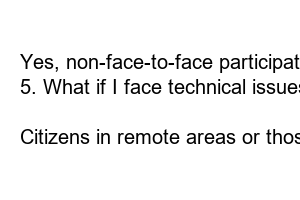주민등록 사실조사 비대면 참여
Title: Non-Face-to-Face Participation in Resident Registration Fact-Finding: The Future of Efficient Citizen Services
Introduction:
In this digital era, where convenience and efficiency are paramount, governments worldwide are relentlessly striving to transform their citizen services. One area where remarkable advancements have taken place is resident registration fact-finding. With the introduction of non-face-to-face participation, citizens can now register their residency in a hassle-free manner, reducing time-consuming visits and paperwork. In this blog post, we will delve into the benefits, process, and concerns surrounding non-face-to-face participation in resident registration fact-finding.
1. The Era of Non-Face-to-Face Participation:
Non-face-to-face participation has revolutionized the way citizens engage with government services. The advancement in technology has enabled governments to utilize online platforms, eliminating the need for citizens to physically visit government offices.
2. The Benefits of Non-Face-to-Face Participation:
By embracing non-face-to-face participation in resident registration fact-finding, governments can offer numerous benefits to their citizens. These include, but are not limited to, streamlined processes, reduced waiting times, increased accessibility, and enhanced efficiency.
3. The Process Simplified:
The process of non-face-to-face resident registration fact-finding involves three simple steps. Citizens can complete an online form providing their personal information, submit relevant documents electronically, and finalize the process by confirming their identity through secure authentication methods.
4. Addressing Security Concerns:
While non-face-to-face participation offers convenience, ensuring data security and preventing fraudulent activities are vital considerations. Governments deploy stringent digital security measures, such as encryption and multi-factor authentication, to safeguard citizens’ personal information.
5. Expanding Accessibility:
One of the significant advantages of non-face-to-face participation is its ability to bridge geographical distances and cater to citizens in remote areas. Citizens no longer need to travel long distances or face inconvenience due to physical disabilities, as they can access registration services from the comfort of their homes.
6. Increased Efficiency:
Non-face-to-face participation has significantly improved the efficiency of resident registration fact-finding processes. It minimizes administrative burden on government offices, reduces paperwork, and optimizes resource utilization. Moreover, citizens can save valuable time, which can be utilized for other important tasks.
7. Future Implications:
The implementation of non-face-to-face participation in resident registration fact-finding is just the beginning of a digital transformation journey for government services. Similar advancements are expected in various other areas, leading to more convenience, accessibility, and digitized interactions between citizens and governments.
Summary:
Non-face-to-face participation in resident registration fact-finding represents a significant step towards efficient citizen services. By embracing this digital approach, governments can offer streamlined processes, reduced waiting times, increased accessibility, and enhanced efficiency. The process, although simplified, requires stringent security measures to protect citizens’ personal information. With the expansion of digitization, accessibility and efficiency in government services are expected to further improve, benefiting citizens worldwide.
FAQs:
1. Is non-face-to-face participation safe?
Yes, governments prioritize data security and implement strong measures like encryption and multi-factor authentication to ensure the safety of citizens’ personal information.
2. How long does the non-face-to-face registration process take?
The process is designed to be quick and efficient, saving citizens time. Depending on the government’s system and verification methods, the process can typically be completed in a matter of days.
3. Can non-face-to-face participation be used for all types of resident registrations?
Non-face-to-face participation is continuously being expanded and improved. However, the availability may vary depending on the country and the specific type of resident registration.
4. Are there any advantages for government offices with this system?
Yes, non-face-to-face participation minimizes administrative burdens, reduces paperwork, and optimizes resource utilization for government offices.
5. What if I face technical issues during the online registration process?
Technical support is usually available to citizens encountering any issues during the online registration process. Government websites typically provide contact information for assistance.
6. How can non-face-to-face participation improve accessibility?
Citizens in remote areas or those facing physical disabilities can benefit the most from non-face-to-face participation, as it eliminates the need for physically visiting government offices.

